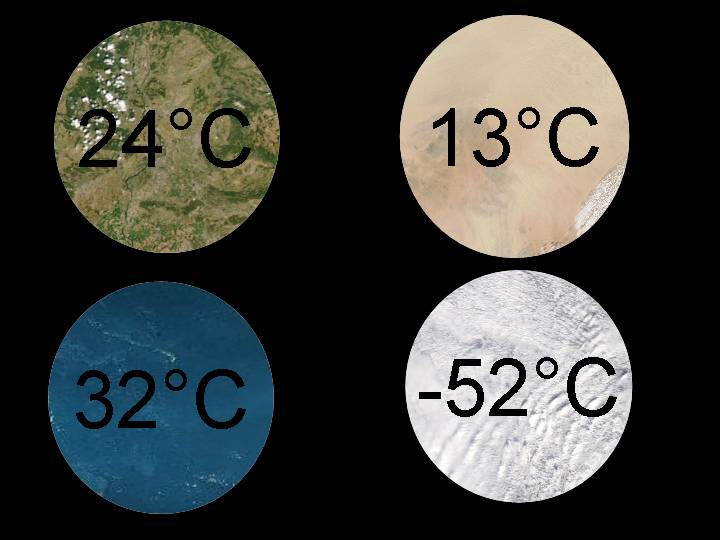|
|
 |
|
|
|
 |
| |
|
|
 |
Clouds & Particles
Basics |
Albedo
Albedo is a latin word (that means whiteness) used to describe how bright something is. It is very important to quantify the earth albedo for the global climate understanding. |
|
|
|
|
 |
Colours
White light (or light from the sun) is composed of several colours that we don't see because they are mixed (you see them separately when looking at a beautiful rainbow or when using a prism). When light hits an object, three things can happen: light can be reflected, transmitted or absorbed.
A mirror reflects all the light arriving on it. Transparent objects (like water, or glass) transmit light through them.
As light is composed of several colours, one part of them can be reflected, and the other part is absorbed. If all of them are reflected, the object colour is white. If none is reflected (all colours are absorbed), the object is dark. If an object absorbs all the colours excepted-let's say- the red colour, your eyes see the red colour and you say the object is red. The absorbed light is transformed into heat: this is why, in summer, dark objects are warmer than bright ones, as they absorb all the colours.
|
|
|
 |
1. Something is colored because of the light it reflects (sent to your eyes); all others colours are absorbed by the object.
Author: J. Gourdeau |
Definition of albedo
The albedo is the ratio of the light reflected by an object to the light it receives.
The number that describe albedo go from 0 (no light reflected) to 1 (all light reflected), or can be expressed in percent. |
|
|
Fresh snow |
80-85 |
|
Old snow |
50-60 |
|
Grass |
20-25 |
|
Forest |
5-10 | |
 |
Albedo on Earth
The average albedo of our planet is around 0.3 : it means that 30% of the sunlight that strikes the Earth is reemitted to the space. Look at the table to see the albedo (in %) of different surfaces. Rainforests have the lowest albedo on Earth.
|
Nowadays the mean Earth surface temperature is 15°C. If our planet was covered with forests (Ewoks planet), average temperature would be 24°C. On a desertic Earth (planet Dune), temperature would be 13°C. If it was covered with oceans (like in the movie Waterworld), temperature would be 32°C, because oceans are dark and hence have a smaller albedo. Planet covered with ice would be cold (-52°C)! (see image 2).
|
 |
 |
 |
|
2. Imaginary temperatures if Earth was covered with different surfaces, that have various albedos. Author: J. Gourdeau.
|
|
Clouds albedo
Our planet’s albedo is very different with or without clouds. Clouds do reflect more light back to space that does blue sky. Albedo of clouds depends on several factors, including the cloud's height, its size, and the number and size of droplets inside the clouds.
Color of clouds is ranging from bright white to dark grey, because of the water droplets scattering light; bigger drops have a larger surface area and reflect more light, as numerous drops do. If you are under a big cumulonimbus cloud, landscape is dark because light does not go trough it easily; but from space, the same cloud would look bright white because it has a strong albedo actually. On the contrary, a cirrus cloud is nearly transparent but seems more grey from the space because its albedo is poor.
Imagine you were in a space shuttle admiring the Earth, clouds would reflect less or more light to the space (that mean, clouds have different albedos), depending on their characteristics.
|
 |
 |
|
3. Albedos of different clouds. Author: J. Gourdeau
|
 |
 |
|
4. Visible satellite image over Europe in November, 2003.
© 2003 EUMETSAT.
|
|
 |
The european satellite METEOSAT measures sunlight reflected by the clouds and surface of the earth. Water absorbs a lot of sunlight, so it appears dark. Thick clouds have high albedos and show up bright in the satellite image. Thin cirrus clouds have low albedos and are usually semi-transparent to sunlight. |
|
Because a cloud usually has a higher albedo than the surface beneath it, the cloud reflects more radiation back to space than the surface would in the absence of the cloud, thus leaving less solar energy available to heat the surface and atmosphere.
This is one link between clouds and climate. But there is another way clouds interact with our climate: let's see the next episode...
You may be interested on albedo in cities, then see here. |
|
About this page...
Author: J. Gourdeau, LaMP Clermont-ferrand, France. Scientific reviewing: Dr Maud Leriche, CNRS LaMP, France.
Last published: 2004-05-06.
|
|
 |
|









